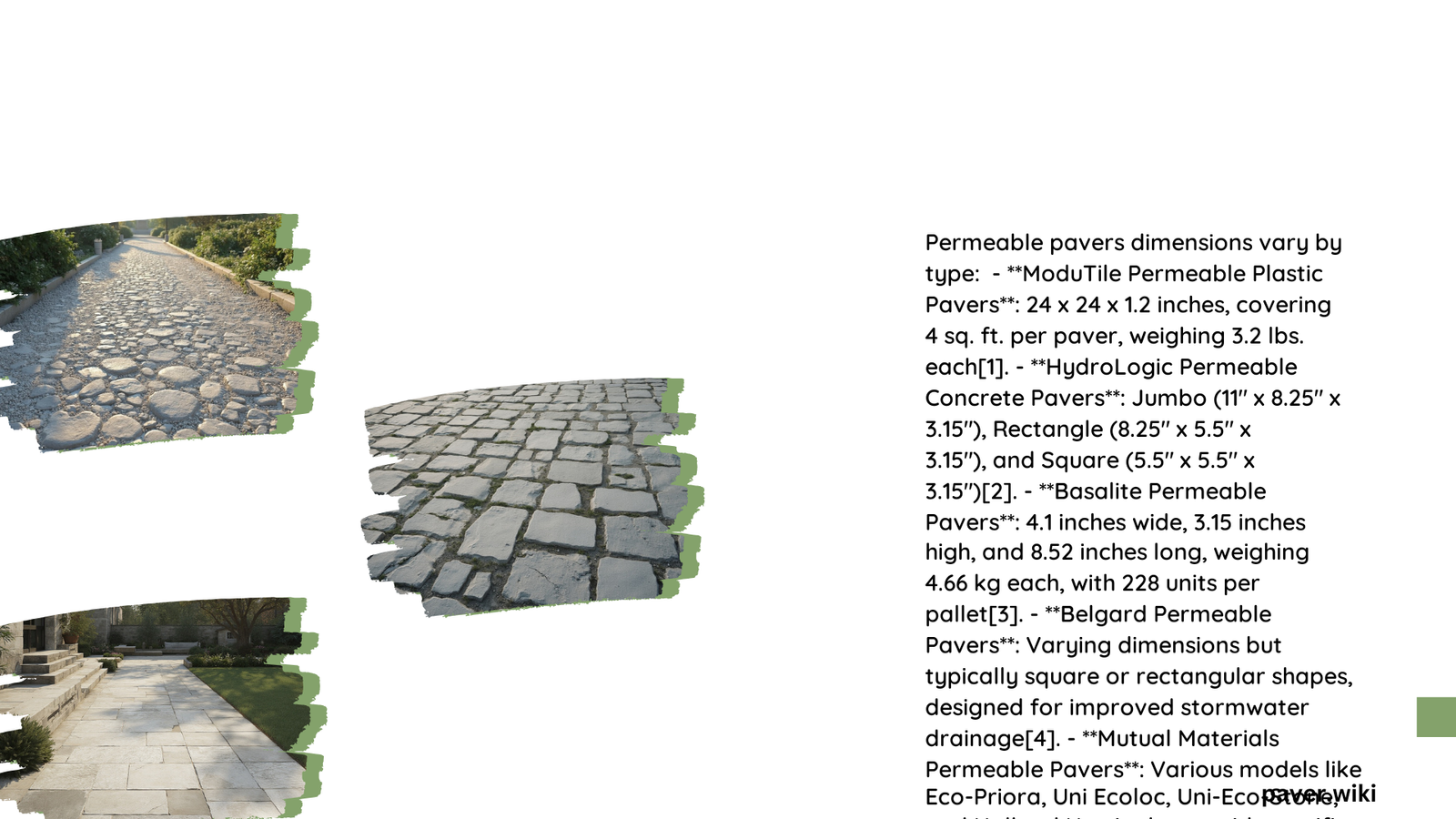Permeable pavers dimensions play a crucial role in sustainable urban design and effective stormwater management. These eco-friendly paving solutions come in various sizes, thicknesses, and configurations, each tailored to specific applications and environmental conditions. Understanding the standard dimensions, thickness ranges, sub-base requirements, and spacing guidelines is essential for optimal performance and longevity of permeable paver installations.
What Are the Standard Dimensions for Permeable Pavers?
Permeable pavers are available in a wide range of sizes to suit different design preferences and functional requirements. Here are some common dimensions:
- Rectangular Pavers:
- 4\” x 8\”
- 6\” x 9\”
-
12\” x 18\” (actual dimensions: 11 3/4\” x 17 5/8\”)
-
Square Pavers:
- 6\” x 6\”
-
12\” x 12\”
-
Specialty Shapes:
- Hexagonal
- L-shaped
- Interlocking patterns
It’s important to note that actual dimensions may vary slightly from nominal sizes due to manufacturing tolerances and design features.
How Does Thickness Affect Permeable Paver Performance?

The thickness of permeable pavers is a critical factor in their performance and application suitability. Here’s a breakdown of thickness ranges and their effects:
| Thickness Range | Typical Applications | Load-Bearing Capacity |
|---|---|---|
| 2\” – 2.5\” | Pedestrian areas, patios | Light foot traffic |
| 3\” – 3.5\” | Driveways, light vehicular traffic | Moderate loads |
| 4\” – 4.5\” | Heavy vehicular traffic, industrial areas | High loads |
Thicker pavers generally offer:
1. Increased structural stability
2. Higher load-bearing capacity
3. Better resistance to freeze-thaw cycles
4. Longer lifespan in high-traffic areas
However, it’s important to note that thickness alone does not determine permeability. The paver design, joint spacing, and sub-base composition all contribute to the overall water infiltration rate.
What Are the Sub-Base Depth Requirements for Permeable Pavers?
The sub-base is a critical component of any permeable paver system. Its depth requirements vary based on several factors:
- Soil Type:
- Well-draining soils may require less depth
-
Clay or poorly draining soils need deeper sub-bases
-
Expected Load:
- Pedestrian areas: Minimum 4\” base course + subbase
-
Vehicular traffic: 6\” or more, depending on load intensity
-
Climate Conditions:
-
Freeze-thaw prone areas require deeper sub-bases for frost protection
-
Stormwater Management Goals:
- Higher water storage needs = deeper sub-base
A typical sub-base structure might include:
– Surface layer: Permeable pavers
– Bedding layer: 1-2\” of fine aggregate
– Base course: 4-6\” of coarse aggregate
– Subbase: 6\” or more of larger aggregate for additional capacity
Always consult local building codes and engineering specifications for precise sub-base depth requirements in your area.
How Should Permeable Pavers Be Spaced for Optimal Drainage?
Proper spacing between permeable pavers is crucial for effective drainage and structural integrity. Here are key considerations:
- Joint Width:
- Minimum: 1/4\” (6.4 mm)
- Maximum: 1/2\” (13 mm)
-
Optimal range: 3/8\” to 1/2\” for most applications
-
Joint Material:
- Use open-graded, washed aggregate (ASTM D448 No. 8, 9, or 89)
-
Avoid sand or fine materials that can clog pores
-
Pattern Design:
- Some patterns, like herringbone, provide better interlock and stability
-
Ensure consistent joint spacing throughout the installation
-
Edge Restraints:
- Install robust edge restraints to prevent paver shifting and maintain joint integrity
Proper spacing allows for:
– Adequate water infiltration
– Structural stability under load
– Compliance with accessibility standards (e.g., ADA requirements)
What Factors Influence the Choice of Permeable Paver Dimensions?
Selecting the right permeable paver dimensions involves considering multiple factors:
- Intended Use:
- Pedestrian vs. vehicular traffic
-
Residential, commercial, or industrial applications
-
Aesthetic Preferences:
- Desired visual patterns and layouts
-
Compatibility with surrounding architecture
-
Site Conditions:
- Soil type and drainage characteristics
-
Slope and topography
-
Local Regulations:
- Stormwater management requirements
-
Building codes and zoning restrictions
-
Maintenance Considerations:
- Larger pavers may be easier to clean and maintain
-
Smaller pavers might offer better flexibility for repairs
-
Budget Constraints:
- Material costs
- Installation complexity
By carefully evaluating these factors, you can choose permeable paver dimensions that balance performance, aesthetics, and cost-effectiveness for your specific project needs.
How Do Permeable Paver Dimensions Compare to Traditional Pavers?
While permeable pavers share some dimensional similarities with traditional pavers, there are key differences:
- Thickness:
- Permeable pavers are often thicker to accommodate larger joint spaces and provide structural stability
-
Traditional pavers may be thinner, especially for pedestrian-only areas
-
Joint Spacing:
- Permeable pavers have wider joints (1/4\” to 1/2\”) filled with permeable aggregate
-
Traditional pavers have tighter joints (1/16\” to 1/8\”) often filled with sand
-
Surface Texture:
- Permeable pavers may have a more open or textured surface to enhance water infiltration
-
Traditional pavers often have smoother surfaces
-
Edge Design:
- Permeable pavers may feature spacer nibs or unique edge designs to maintain consistent joint widths
-
Traditional pavers typically have straight edges for tight installation
-
Size Variety:
- Both types offer a range of sizes, but permeable pavers may have more specialized shapes designed for optimal water flow
Understanding these differences is crucial when transitioning from traditional to permeable paving systems or when integrating both types in a single project.
In conclusion, the dimensions of permeable pavers are a critical aspect of their design and functionality. By carefully considering standard sizes, thickness options, sub-base requirements, and spacing guidelines, you can create effective, sustainable, and visually appealing permeable paving solutions for a wide range of applications.
References:
1. Hanover Architectural Products – Permeable 12″ x 18″
2. Brick Industry Association – Permeable Clay Brick Pavements
3. Belgard – Permeable Pavers for Patio or Driveway
